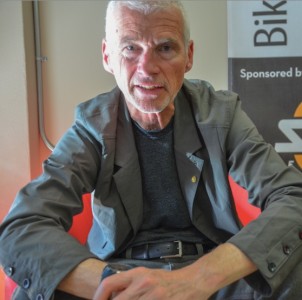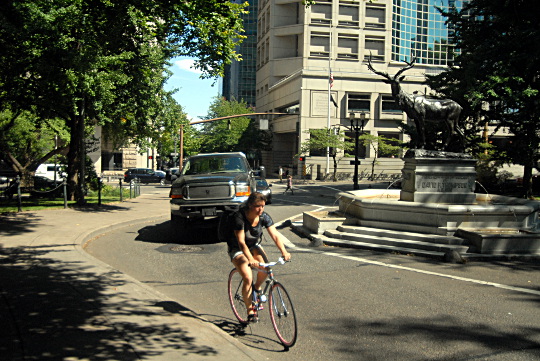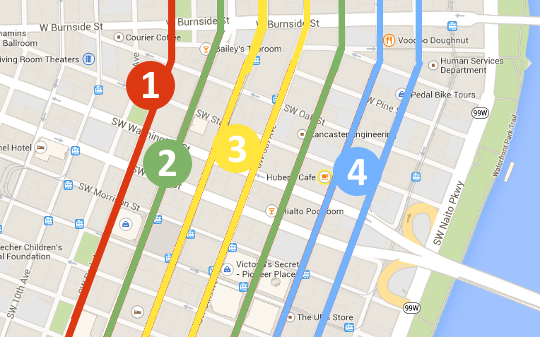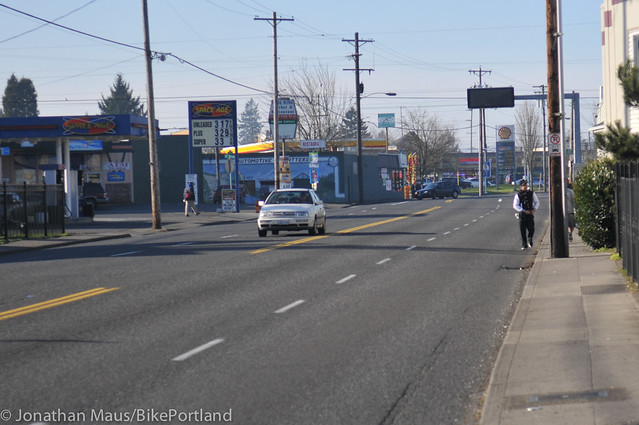
Central City Multimodal Safety Project, stopped by the
BikePortland office for a chat Tuesday.
(Photos: M.Andersen and J.Maus/BikePortland)
Rick Browning is already a big part of Portland as we know it. His fingerprints are on everything from the streetscape reconstruction that helped make inner Alberta Street a regional destination to the transformational 1999 widening of the Hawthorne Bridge sidewalk to the bike path that leads straight into our airport’s terminal.
This morning, he started a job working on one of the most significant bike projects of his career: one or more protected bike lanes across downtown Portland.
As we reported earlier this month, downtown is probably the most bike-intensive part of the city that has almost no all-ages bike infrastructure. But what else will the project include, and how will he help the city navigate the many obstacles to change? We sat down with Browning Wednesday night for an advance look at his idea of his mission, the decisions he’ll need to help make and whether downtown bike infrastructure should be a priority at all.
BikePortland: The description of this project has been a little vague. What do you know so far about its scope?
Rick Browning: You may know more about the scope of the process than I do. That was not a big part of the selection process. I think the big concepts still need to be ideated.
My understanding of the project is that Portland has sort of plateaued on mode split. You guys have run some articles over the last few years on that. We’ve come so far — it’s incredible. But it’s exactly where all the national polls predicted we would be. We’ve been doing these polls for 20 years; the results are very consistent among a majority of Americans. They would like to ride — for work, for errands — but they don’t feel safe. My goal is to help that larger percentage of people feel that they can ride.

What do you see as the main challenges before you?
Obviously the challenge in the downtown is just the constrained nature of the downtown. Everybody’s aware of that. What tradeoffs will need to be made to find more space for bike and, to some degree, pedestrian modes?
“We all want to make our city a more enjoyable, more livable, safer place and better for biking and walking. I think it would be wrong to not do those things because we’re afraid of gentrification.”
I’m very impressed with the work Janette Sadik-Khan and company did in New York. I saw her speak a few weeks ago in Seattle. The work she did there in New York, I think everybody agrees is transformative. She didn’t just focus I think on what it did for bikes and pedestrians, she focused on what it did for businesses as well. She was also able to present percentage of increased retail sales for businesses adjacent to those projects. If we can do that here, I think that’d be fantastic. Not that that’s the primary goal, but I think we need all the friends we can. Sales have increased dramatically — she was talking about increases in sales of up to and over 100 percent on some of these installations. That seems like a win-win.
I’ve heard some people say Portland needs a new business association to represent the interests of businesses that benefit when streets are places to be rather than just places to move things quickly. Obviously you’re not going to engineer that, but if someone else were able to, how would that relate to your work here?
If this project is successful in the way we’re discussing, it becomes a demonstration project that shows what New York found, among other cities: that these kind of projects are actually good for business. Maybe that’ll create new momentum for businesses that are on the fence.
Again, that should not be the litmus test for this project. I don’t mean in any way to make it that. But if we can get the most bang for our buck, then we would all win.
Advertisement
Not that many people live in downtown, but —
I am one! I moved into the Ladd Tower. It’s a great place to live, but it was a deliberate choice. I’ve always found that the more you personally experience a place you’re trying to upgrade or design, the better. So I’ll be walking around and breathing it every day.
One thing about Sadik-Khan’s work is that it was happening in the teeth of a recession, and everybody was interested in jobs, jobs, jobs. These days I think the single biggest issue in Portland is rising real estate prices and displacement. On the way here today, I was riding down Third Avenue — it’s a surprisingly run-down street, with two-story buildings, a vacant lot in the middle of downtown. If we slow the speed and volume of traffic there, it’ll become a better place to sit on the sidewalk, which means it’ll be a better place for someone to spend $80 million. But on the other hand, the Silverado can afford to pay the rent in its old building, and that has cultural benefits. Do you see problems along those lines with improving these streets?
You’re talking about gentrification?
Yeah, or displacement.
That gets into a lot of other issues that the city confronts that are beyond cycling. We all want to make our city a more enjoyable, more livable, safer place and better for biking and walking. I think it would be wrong to not do those things because we’re afraid of gentrification. But I think we need a whole basket of policies.
Another thing is that lower-income people are more reliant, I think, on cycling and walking. Those are not the people that typically show up at city council hearings to encourage that sort of development and planning. But lower-income people that ride because they need to ride to get to work, that’s part of Portland too.
Do you have any thoughts on the big unanswered question of which north-south streets should be improved?
None at all. And I think that makes me kind of a good candidate for the job, because I’m not coming in with any preconceptions. And looking for maybe something that’s a little bit counterintuitive and outside the box.
I’m a designer and an architect. If you go in with fixed models and preconceived solutions, almost always you wind up with a weaker final product than being open to exploration.
Although, since I live on the Park Blocks … (laughs)
“The $6 million grant that I hear PBOT has is more per capita than, according to my calculations, Sadik-Khan had to work with in New York to do everything she did.”
How do you feel about the size of the budget?
When I saw Janette Sadik-Khan speak in Seattle, she had a pie chart that showed the overall transportation project New York had, I think it was over a three-year period. I did the math proportional to Portland’s population and New York’s population, and per capita the $6 million grant that I hear PBOT has is more per capita than, according to my calculations, Sadik-Khan had to work with in New York to do everything she did.
Of course, New York is now going back and trying to formalize some of those projects like Times Square, and they’re going to do stuff with concrete and permanent installations that are going to cost a lot more money. I’m going to go out on a limb here and say I don’t think we can remake the entire central city for $6 million.
Another thing we grapple with here is that downtown Portland is already a really nice place. And most of east Portland isn’t even safe. So how can we justify further investment in downtown?
I understand the concern, and have spent some time trying to ride a bike in far east Portland, so I know firsthand what motivates the comments. And I don’t have an easy answer to that. I might fall back on an aphorism I learned while living in Seattle for five years or so. In Seattle, every neighborhood has its own downtown, and in Portland, downtown is everybody’s neighborhood. I think that’s true. It’s not that there’s even that many people living downtown, but Portlanders in general will converge on downtown and use it. So to that degree is our most heavily used, most popular built environment resource. But that doesn’t mean other areas of the city shouldn’t also see investment.
I was reading in the Willamette Week bike issue that there’s a road diet planned on … is it Powell?
Foster.
Foster. I think it’s an example of a way that the city is dedicating a substantial resource to a sort of far-flung area, and indeed the budget for that is fairly close to what they have for the central city. Still, it shows there’s investment happening elsewhere and that’s the way it should be.
You don’t own a car now. Have you ever?
It’s been about eight years. And it really isn’t about car ownership, right? It’s about how much you drive the car. And I was not a big user ever. I get around on bike, foot, bus, car2go. It’s great to be back in a city with all these great transit options. For the last couple years I was living in Olympia.
Now that you’re back here, would you like to stay in Portland when this project wraps up?
I would. I want to enjoy the fruits of my labors. I hope my Seattle girlfriend will forgive me for saying that.




